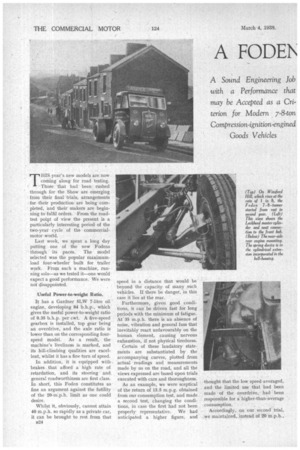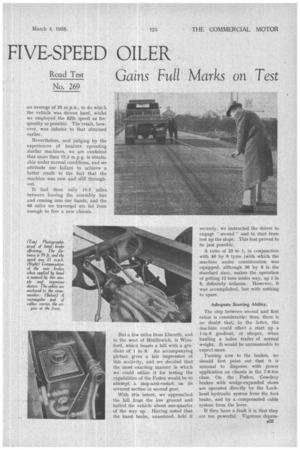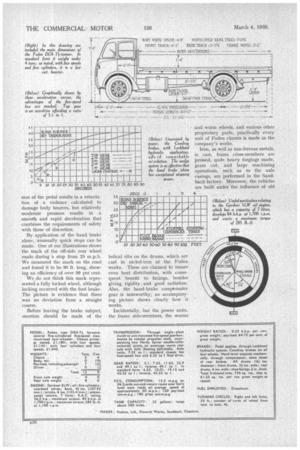A FODEN FIVE-SPEED OILER
Page 34

Page 35

Page 36

Page 37

If you've noticed an error in this article please click here to report it so we can fix it.
Gains Full Marks on Test A Sound Engineering Job with a Performance that may be Accepted as a Criterion for Modern 7-8-ton Compression-ignition-engined
Goods Vehicles
THIS year's new models are now coming along for road testing. Those that had been rushed through for the Show are emerging from their final trials, arrangements for their production are being completed, and their makers are beginning to fulfil orders. From the roadtest poiV of view the present is a particularly interesting period of the two-year cycle of the commercialmotor world.
Last week, we spent a long day putting one of the new Fodens through its paces. The model selected was the popular maximumload four-wheeler built for trailer work. From such a machine, running solo—as we tested it—one would expect a good performance. We were not disappointed.
Useful Power-to-weight Ratio.
It has a Gardner 5LW 7-litre oil engine, developing 84 b.h.p., which gives the useful power-to-weight ratio of 0.35 b.h.p. per cwt. A five-speed gearbox is installed, top gear being an overdrive, and the axle ratio is lower than on the corresponding fourspeed model. As a result, the machine's liveliness is marked, and its hill-climbing qualities are excellent, whilst it has a fine turn of speed.
In addition, it is equipped with brakes that afford a high rate of retardation, and its steering and general roadworthiness are first Class. In short, this Foden constitutes as fine an argument against the futility of the 20-m.p.h. limit as one could desire.
Whilst it, obviously, cannot attain 40 m.p.h. so rapidly as a private car, it can be brought to rest from that B24 speed in a distance that would be beyond the capacity of many such vehicles. If there be danger, in this case it lies at the rear.
Furthermore, given good conditions, it can be driven fast for long periods with the minimum of fatigue. At 35 m.p.h. there is an absence of noise, vibration and general fuss that inevitably react unfavourably on the human element, causing nervous exhaustion, if not physical tiredness.
Certain of these laudatory statements are substantiated by the accompanying curves, plotted from actual readings and measurements made by us on the road, and all the views expressed are based upon trials executed with care and thoroughness.
As an example, we were sceptical of the return of 15.5 m.p.g. obtained from our consumption test, and made a second test, changing the conditions, in case the first had not been properly representative. We had anticipated a higher figure. and thought that the low speed averaged, and the limited use that had been made of the overdrive, had been responsible for a higher-than-average consumption.
Accordingly, on our second trial, we maintained, instead of 20 m.p.h.,
an average of 25 m.p.h., to do which the vehicle was driven hard, whilst we employed the fifth speed as frequently as possible. The result, however, was inferior to that obtained earlier.
Nevertheless, and judging by the experiences of hauliers operating similar machines, we are confident that more than 15.5 m.p.g. is obtainable under normal conditions, and we attribute our failure to achieve a better result to the fact that the machine was new and stiff throughout.
It had done only 19.5 miles between leaving the assembly line and coming into our hands, and the 68 miles we traversed are far from enough to free a new chassis.
But a few miles from Elworth, and to the west of Middlewich, is Winsford, which boasts a hill with a gradient of 1 in 8. An accompanying picture gives a fair impression of this acclivity, and we decided that the most exacting manner in which we could utilize it for testing the capabilities of the Foden would be to attempt a stop-and-restart on its severest section in second gear.
With this intent, we approached the hill from the low ground and halted the vehicle about one-quarter of the way up. Having noted that the hand brake, unassisted, held it securely, we instructed the driver to engage " second " and to start from rest up the slope. This feat proved to he just possible.
A ratio of 23 to 1, in conjunction with 40 by 8 tyres (with which the machine under consideration was equipped, although 36 by 8 is the standard size), makes the operation of getting 12 tons under way, up 1 in 8, definitely arduous. However, it was accomplished, but with nothing. to spare.
Adequate Starting Ability.
The step between second and first ratios is considerable; thus, there is no doubt that, in the latter, the machine could effect a start up a 1-in-6 gradient, or steeper, when hauling a laden trailer of normal weight. It would be unreasonable to expect more.
Turning now to the brakes, we should first point out that it is unusual to dispense with power application on chassis in the 7-8-ton class. On the Foden, Cowdrey brakes with wedge-expanded shoes are operated directly by the Lockheed hydraulic system from the foot brake, and by a compensated cable system from the lever.
If they have a fault it is that they aro too powerful. Vigorous depresB25 sion of the pedal results in a retardation of a violence calculated to damage body bearers, but relatively moderate pressure results in a smooth and rapid deceleration that combines the requirements of safety with those of discretion.
By application of the hand brake alone, unusually quick stops can be made. One of our illustrations shows the track of the off-side rear wheel made during a stop from 25 m.p.h. We measured the mark on the road and found it to be 39 ft. long, showing an efficiency of over 50 per cent.
We do not think this mark represented a fully locked wheel, although locking occurred with the foot brake. The picture is evidence that there was no deviation from a straight course.
Before leaving the brake subject, mention should be made of the
helical ribs on the drums, which are cast in nickel-iron at the Foden works. These are claimed to insure even heat distribution, with consequent benefit to facings, besides giving rigidity, and good radiation. Also, the hand-brake compensator gear is noteworthy; an accompanying picture shows clearly how it works.
Incidentally, bar the power units, the frame side-members, the worms and worm wheels, and various other proprietary parts, practically every unit of Foden chassis is made in the company's works.
Iron, as well as non-ferrous metals, is cast, frame cross-members are pressed, quite heavy forgings made, gears cut, and large machining operations, such as to the axle casings, are performed in the Sandbach factory. Moreover, the vehicles are built under the influence of old steam traditions, and one gains the impression that a respect for engineering laws pervades all departments.
In connection with the accompanying acceleration graph, there is little to add to the story told.by the curves. The ratios selected enable full advantage to be taken of the characteristics of the power unit, and the speed range is more than adequate for requirements. It will be noted that, in direct drive, the vehicle can pick up quickly from
10 m.p.h., whilst the top ratio can be used in most circumstances down to 20 m.p.h. and lower.
For maximum acceleration, however, the ultimate upward change should be delayed until about 25 m.p.h. has been attained, and " fourth" should be engaged when speed drops from a higher figure to about this velocity.
The driving comfort, apart from the practical value, of the overdrive needs to be experienced to be appreciated. We have already mentioned the smooth running of the power unit. This is largely attributable to the method of suspending it in the frame, which is a new feature. Both rear and front fixings are illustrated.
The single forward mounting comprises, essentially, a rectangular plate resting on a rubber pad of similar shape, whilst the weight at the bell-housing is supported on stiff compression springs accommodated in housings formed in the casting, the rubbers serv ing as rebound buffers. The link, seen in the picture, is primarily for lateral location.
The functioning of the system is satisfactory, vibration being practically negligible, except at tick over speeds. In the same connection, the noise, despite the close juxtapo sition of the engine and driver in a confined space, is moderate, judged by compression ignition engine standards.
Besides major matters and chassis details, first-class workmanship is found in the incidentals, whilst the equipment does not appear to have been regarded as something on which money could be saved.
The cab is well built, with ash framing and aluminium panelling, the finish is excellent and no signs of undesirable cost or weight-cutting are revealed by the most searching investigation. This Foden may be summed up as a thoroughly sound proposition, represepting all that is best in British practice.




















































































